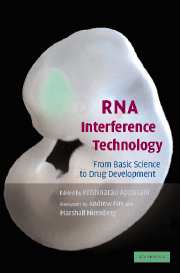Book contents
- Frontmatter
- Contents
- Foreword by Andrew Fire
- Foreword by Marshall Nirenberg
- List of Contributors
- Introduction
- Section one Basic RNAi, siRNA, microRNAs and gene-silencing mechanisms
- Section two Design, synthesis of siRNAs
- Section three Vector development and in vivo, in vitro and in ovo delivery methods
- Section four Gene silencing in model organisms
- 17 Practical applications of RNAi in C. elegans
- 18 Inducible RNAi as a forward genetic tool in Trypanosoma brucei
- 19 RNA-mediated gene silencing in fission yeast
- 20 RNA silencing in filamentous fungi: Mucor circinelloides as a model organism
- 21 RNAi and gene silencing phenomena mediated by viral suppressors in plants
- Section five Drug target validation
- Section six Therapeutic and drug development
- Section seven High-throughput genome-wide RNAi analysis
- Index
- Plate section
- References
18 - Inducible RNAi as a forward genetic tool in Trypanosoma brucei
Published online by Cambridge University Press: 31 July 2009
- Frontmatter
- Contents
- Foreword by Andrew Fire
- Foreword by Marshall Nirenberg
- List of Contributors
- Introduction
- Section one Basic RNAi, siRNA, microRNAs and gene-silencing mechanisms
- Section two Design, synthesis of siRNAs
- Section three Vector development and in vivo, in vitro and in ovo delivery methods
- Section four Gene silencing in model organisms
- 17 Practical applications of RNAi in C. elegans
- 18 Inducible RNAi as a forward genetic tool in Trypanosoma brucei
- 19 RNA-mediated gene silencing in fission yeast
- 20 RNA silencing in filamentous fungi: Mucor circinelloides as a model organism
- 21 RNAi and gene silencing phenomena mediated by viral suppressors in plants
- Section five Drug target validation
- Section six Therapeutic and drug development
- Section seven High-throughput genome-wide RNAi analysis
- Index
- Plate section
- References
Summary
Introduction to RNAi in Trypanosomes
In December 1998 the Ullu lab at Yale published the first report of dsRNA-mediated mRNA degradation in Trypanosoma brucei (Ngo et al., 1998). These experiments used either electroporation of in vitro synthesized dsRNA or transient in vivo expression of single-strand RNA that forms a stem–loop structure capable of inducing RNAi. At that time, the arsenal of genetic techniques available to the trypanosome researcher was limited (Clayton, 1999). For example, gene knockout was possible through homologous recombination, although the diploid genome of T. brucei complicated this approach. Furthermore, essential genes were difficult to examine by knockout, necessitating complex strategies in which inducible ectopic expression needed to be maintained while the genomic knockouts were generated (Wirtz et al., 1999). RNAi raised hopes for a powerful and convenient genetic approach for these eukaryotes.
Our lab has made extensive use of RNAi in studying gene function in T. brucei, the eukaryotic parasite that causes African sleeping sickness. The purpose of this chapter is to review the steps our lab has taken in developing an inducible RNAi system that has allowed us to achieve the goal of bona fide RNAi-based forward genetics in T. brucei. In addition, this chapter will review our development of an easy-to-use, inducible RNAi system, presenting a few examples of how this approach has allowed us to gain new insights into gene function, especially in the case of essential genes.
- Type
- Chapter
- Information
- RNA Interference TechnologyFrom Basic Science to Drug Development, pp. 247 - 256Publisher: Cambridge University PressPrint publication year: 2005



